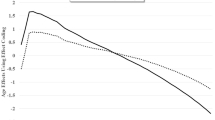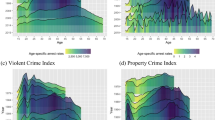Abstract
Methodological problems arising in fitting nonlinear regressions to a dataset are identified in context of research on the age-crime relationship. A modified chisquare distribution is fit to the age distribution of the seven Index crimes for the years 1952, 1957, 1962, 1967, 1972, 1977, 1982, and 1988 to assess the historical invariance of the distribution. Problematic features of Britt's (J. Quant. Criminol. 8, 175–187, 1992) analysis of the same data are highlighted.
Similar content being viewed by others
References
Britt, C., III (1992). Constancy and change in the U.S. distribution of crime: A test of the “invariance hypothesis.”J. Quant. Criminol. 8: 175–87.
Farrington, D. P. (1986). Age and crime. In Tonry, M., and Morris, N. (eds.),Crime and Justice: An Annual Review of Research, Vol. 7, pp. 189–250.
Gottfredson, M. R., and Hirschi, T. (1990).A General Theory of Crime, Stanford University Press, Stanford, CA.
Greenberg, D. F. (1977). Delinquency and the age structure of society.Contemp. Cris. 1: 189–223.
Greenberg, D. F. (1991). Modeling criminal careers.Criminology 29: 17–46.
Greenberg, D. F., and Larkin, N. J. (1985). Age-cohort analysis of arrest rates.J. Quant. Criminol. 1: 227–241.
Hirschi, T., and Gottfredson, M. R. (1983). Age and the explanation of crime.Am. J. Sociol. 89: 552–584.
Hirschi, T., and Gottfredson, M. R. (1985). Age and crime: Logic and scholarship.Am. J. Sociol. 91: 22–27.
Klepinger, D. H., and Weis, J. G. (1985). Projecting crime rates: An age, period, and cohort model using ARIMA techniques.J. Quant. Criminol. 1: 387–416.
O'Brien, R. M. (1989). Relative cohort size and age-specific crime rates: An age-period-relativecohort-size model.Criminology 27: 57–78.
Rowe, D. C., Osgood, D. W., and Nicewander, A. W. (1990). A latent trait approach to unifying criminal careers.Criminology 28: 237–270.
Steffensmeier, D. J., Allan, E. A., Harer, M. D., and Streifel, C. (1989). Age and the distribution of crime.Am. J. Sociol. 94: 803–831.
Zedlewski, E. (1985).Youth, Crime and Deterrence: What Matters? U.S. Department of Justice, Washington, D.C..
Author information
Authors and Affiliations
Additional information
Britt states no rationale for the choice of these two functions, but his statement that his findings “provide support for Greenberg's (1991) use of the Poisson gamma density to model individual offending patterns and questions Rowe and co-workers' (1990) use of the lognormal density as an appropriate model of individual violent offending” suggests that this earlier work motivated his choice. Actually, this earlier work is not relevant to Britt's project. Greenberg (1991) and Roweet al. (1990) were concerned with the distribution of criminal propensities across individuals of a given age, not with the distribution of prevalence or participation rates across the ages, and changes therein over time.
Rights and permissions
About this article
Cite this article
Greenberg, D.F. The historical variability of the age-crime relationship. J Quant Criminol 10, 361–373 (1994). https://doi.org/10.1007/BF02221281
Issue Date:
DOI: https://doi.org/10.1007/BF02221281




